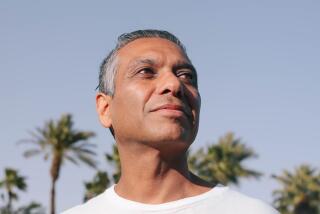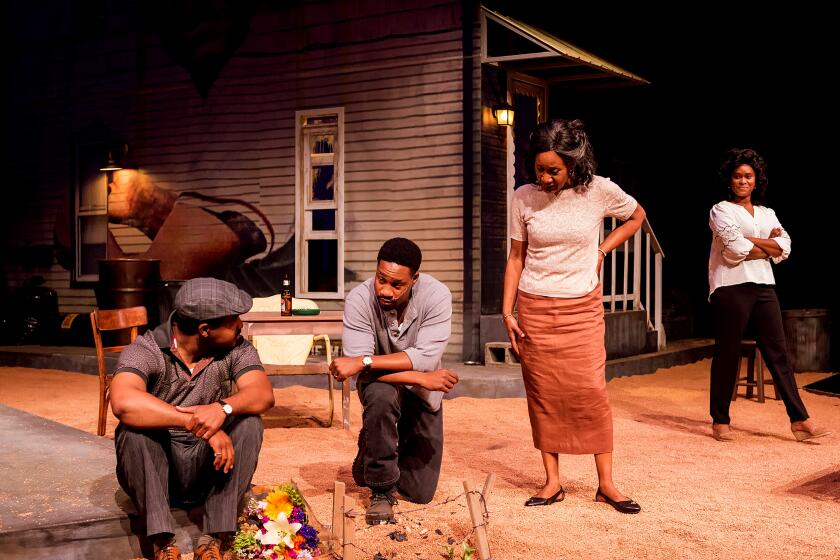An Exposition of civic issues
Big changes are coming to Exposition Park.
The Endeavour space shuttle, NASA announced last month, will be moving to the California Science Center campus -- though not to Frank Gehry’s cramped 1984 Air and Space Gallery, whose future is, well, up in the air. The UCLA basketball team will take up temporary residence this fall at Welton Becket’s 1959 Los Angeles Memorial Sports Arena, another candidate for future demolition. And a new Metro light-rail line along Exposition Boulevard, nearly complete, will knit the park into the regional transit grid even as its impact at ground level promises to be something of a disaster.
Then again, big changes are always coming to Exposition Park, aren’t they? The 160-acre park has long been a microcosm of Los Angeles -- the fragmented, quickly growing city in miniature. It has continually absorbed not just new buildings but new visions of L.A.’s civic character.
In that sense, the latest developments -- and the promise and anxiety they bring -- look awfully familiar. How to protect or carve out open space, how to fit new transit lines atop a built-out city, how to gauge the historical value of idiosyncratic postwar landmarks: These are pressing questions not just for Exposition Park and the neighborhood around it but for Los Angeles and most of Southern California.
In a paradoxical sense, the park’s incoherence has been its only constant over the years. A place that began its civic life, in 1913, as a symmetrical Beaux-Arts garden went on to welcome two Olympic Games, in 1932 and 1984, and to reflect the complicated relationship that USC and South Los Angeles maintain with the larger city and with each other. In the postwar decades, new surface parking lots began to crowd out what was left of the park’s open space.
In part to grapple with those inconsistencies, and to plot its post-Olympic identity, the architecture firm Zimmer Gunsul Frasca was hired two decades ago to produce a new master plan for the park. That document, unveiled in 1992, guided a burst of construction, notably the expansion of the Science Center campus, where a new building by ZGF opened in 1998.
It also anticipated yet another wing at the Science Center at some future date, though the announcement last month from NASA that it will be bringing Endeavour to Los Angeles has complicated and perhaps accelerated those plans. Jeffrey N. Rudolph, the Science Center’s president and chief executive, told me that he hopes to select an architect for a new wing this summer.
The retiring space shuttle could be displayed vertically, sitting on a replica of its launching pad. That would give the Science Center a chance to build a new tower -- a new landmark for the park visible from the surrounding streets and the freeway. In the short term, Rudolph is considering commissioning a temporary structure to display the shuttle while the new wing is planned and built.
What all of that means for the future of Gehry’s Air and Space Gallery is less certain. The public has always been lukewarm about the building. It was not a lavish design to begin with; it relied on Gehry’s now-famous informality and fondness for workaday materials. On top of that, construction was rushed to make sure it would open before the 1984 Olympics, and its upkeep since then has been uneven. Rumors began swirling a few weeks ago that it might have a target on its back.
When I asked Rudolph about the fate of the Gehry building, he told me, “I honestly don’t know.” He added that working with its interior layout “has always been a challenge,” and, in terms of its possible demolition, “I never rule anything out.” That hardly adds up to a vote of confidence for the building.
In the last few years, despite Gehry’s status as the most famous and among the most influential architects in the world, the Air and Space Gallery has fallen into something of a historical blind spot. Very few buildings from the early 1980s -- even those by very talented architects -- look particularly appealing to 2011 eyes.
That, in the end, is among the strongest arguments for saving the building. It will never look as unfashionable, or less valuable, as it does at the moment. A decade from now, its importance as a piece of architecture will be far clearer for the public to see. And as an example of Gehry’s transition from small-scale, mostly residential work to larger civic projects -- and of the moment when his jumbled, sometimes intentionally crude aesthetic began to win official respect -- its value and historical importance are self-evident.
Still, even Gehry acknowledges the building needs work. The clear solution is for Rudolph to ask Gehry and his firm to re-imagine it for new programmatic uses, as the Science Center’s aerospace displays will naturally move to join the shuttle in a new wing. A separate fundraising effort could be planned to bring the building back to life, a project that would make a fascinating late-career opportunity for Gehry, who is 82. How often are architects given the chance to revisit and reinvent a project whose shortcomings always nagged at them?
The Sports Arena, alas, is a different case. UCLA’s decision to play its home basketball games there while Pauley Pavilion -- another Welton Becket design -- is being renovated will bring a new generation of fans into its circular interior. Some of them may cast an appreciative eye at the streamlined postwar profile of the building, which in functional as well as architectural terms is a better design than Pauley.
And although it doesn’t have the same legacy of championship basketball that Pauley does, the Sports Arena’s historical resume is long. It was the site of the 1960 Democratic Convention, where its forward-looking architecture was a perfect match for the fresh-faced candidacy of John F. Kennedy. The UCLA basketball team, under John Wooden, played at the Sports Arena from 1959 to 1965.
But the opening of HNTB Architecture’s Galen Center on the edge of the USC campus in 2006 made the arena, which had been home to that school’s basketball teams since 1959, largely redundant. And even a groundswell of support is unlikely to save it.
An Environmental Impact Report prepared recently by the Coliseum Commission, which controls the Sports Arena, envisions a range of possible replacements for the building, including a 22,000-seat soccer stadium. Times reporter Lance Pugmire wrote last month that, despite the arrival of UCLA basketball, the Sports Arena is moving “inexorably toward demolition.” The Bruins, of all teams, will be in essence giving it a season-long send-off.
No element of Exposition Park, meanwhile, reflects the potential of the area -- or the difficulties of unifying it -- more than the Metro light-rail line that is being built along Exposition Boulevard, with stops set to open later this year (or in early 2012) at the park’s northwest and northeast corners. The arrival of the line will mean wonders for the park’s connection -- literal and psychological -- with the rest of downtown and for the future of the Figueroa Street corridor, parts of which are now being redesigned to be more friendly to cyclists and pedestrians.
But as a piece of urban design, this stretch of the Expo Line is shaping up as a huge disappointment. The line emerges from underground along Exposition Boulevard just west of Figueroa, and for most of its route along Exposition it is contained within two lines of black fencing. Even before it has opened, the train line has managed to produce an imposing new barrier between the park and the USC campus.
The barrier, sadly enough, is the perfect symbolic gateway for this unsettled patch of Los Angeles real estate -- and for a city, for all its global ambition, that is still divided in so many ways against itself.
christopher.hawthorne@latimes.com
More to Read
The biggest entertainment stories
Get our big stories about Hollywood, film, television, music, arts, culture and more right in your inbox as soon as they publish.
You may occasionally receive promotional content from the Los Angeles Times.







